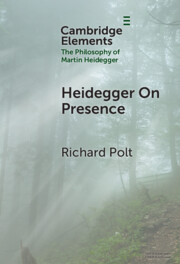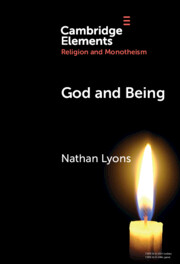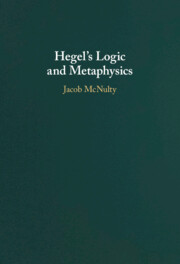Refine search
Actions for selected content:
49 results
Chapter 7 - Plato
-
- Book:
- Aggregation and Antithesis in Ancient Greece
- Published online:
- 21 October 2025
- Print publication:
- 28 August 2025, pp 173-190
-
- Chapter
- Export citation
Chapter 1 - Being and Time as a Whole: From Pragmatism, to Existentialism, to a Philosophy of Being, via the Good
-
-
- Book:
- Heidegger's <i>Being and Time</i>
- Published online:
- 28 June 2025
- Print publication:
- 26 June 2025, pp 7-30
-
- Chapter
- Export citation
Chapter 2 - The Trouble with the Ontological Difference
-
-
- Book:
- Heidegger's <i>Being and Time</i>
- Published online:
- 28 June 2025
- Print publication:
- 26 June 2025, pp 31-48
-
- Chapter
- Export citation
Chapter 12 - Heidegger on the Failure of Being and Time
-
-
- Book:
- Heidegger's <i>Being and Time</i>
- Published online:
- 28 June 2025
- Print publication:
- 26 June 2025, pp 248-273
-
- Chapter
- Export citation
Chapter 7 - The Fourth Way
-
- Book:
- Reading Aquinas's Five Ways
- Published online:
- 05 June 2025
- Print publication:
- 19 June 2025, pp 155-187
-
- Chapter
- Export citation

Heidegger On Presence
-
- Published online:
- 04 March 2025
- Print publication:
- 27 March 2025
-
- Element
- Export citation
5 - Systematic Theology
- from Part II - Paul Tillich and Personal Salvation
-
- Book:
- Salvation in the Block Universe
- Published online:
- 09 January 2025
- Print publication:
- 23 January 2025, pp 139-183
-
- Chapter
- Export citation
Poverty and Richness of Arguments in Lorenzo Valla
-
- Article
-
- You have access
- Open access
- HTML
- Export citation
Chapter 9 - Is Collingwood a Process Philosopher?
- from Part II - Issues in Collingwood’s Philosophy
-
-
- Book:
- Interpreting R. G. Collingwood
- Published online:
- 22 November 2024
- Print publication:
- 05 December 2024, pp 161-183
-
- Chapter
- Export citation
10 - Looking Above: The Third Pair of Wings and the Crucified Christ
- from Part II - Commentary
-
- Book:
- Bonaventure's 'Journey of the Soul into God'
- Published online:
- 23 November 2024
- Print publication:
- 28 November 2024, pp 392-416
-
- Chapter
- Export citation
9 - Pamprosopon
- from Part III - Intellect
-
- Book:
- Plotinus on the Contemplation of the Intelligible World
- Published online:
- 03 September 2024
- Print publication:
- 21 November 2024, pp 319-351
-
- Chapter
- Export citation
8 - There Is Only One World
- from Part III - Intellect
-
- Book:
- Plotinus on the Contemplation of the Intelligible World
- Published online:
- 03 September 2024
- Print publication:
- 21 November 2024, pp 294-318
-
- Chapter
- Export citation
Chapter 10 - Being and Existence in the Consolation of Philosophy
-
-
- Book:
- Boethius’ ‘Consolation of Philosophy’
- Published online:
- 23 May 2024
- Print publication:
- 30 May 2024, pp 169-185
-
- Chapter
- Export citation
Chapter 4 - Are Platonic Forms Concepts?
-
-
- Book:
- Conceptualising Concepts in Greek Philosophy
- Published online:
- 25 April 2024
- Print publication:
- 02 May 2024, pp 74-95
-
- Chapter
-
- You have access
- Open access
- HTML
- Export citation
18 - The Growth Point
- from Part IV - Gestures in Relation to Cognition
-
-
- Book:
- The Cambridge Handbook of Gesture Studies
- Published online:
- 01 May 2024
- Print publication:
- 18 April 2024, pp 477-500
-
- Chapter
- Export citation

God and Being
-
- Published online:
- 30 November 2023
- Print publication:
- 21 December 2023
-
- Element
- Export citation
11 - Thomas Mann and Martin Heidegger
- from III - Heidegger and Literary Works
-
-
- Book:
- Heidegger and Literary Studies
- Published online:
- 09 November 2023
- Print publication:
- 23 November 2023, pp 278-318
-
- Chapter
- Export citation
Aquinas on The Distinction Between Esse and Esse: How the Name ‘Esse’ Can Signify Essence
-
- Journal:
- New Blackfriars / Volume 104 / Issue 1114 / November 2023
- Published online by Cambridge University Press:
- 01 January 2024, pp. 628-650
- Print publication:
- November 2023
-
- Article
- Export citation
6 - Being and Worlds
-
- Book:
- An Introduction to Mesoamerican Philosophy
- Published online:
- 28 July 2023
- Print publication:
- 03 August 2023, pp 166-191
-
- Chapter
- Export citation

Hegel's Logic and Metaphysics
-
- Published online:
- 26 April 2023
- Print publication:
- 26 January 2023
